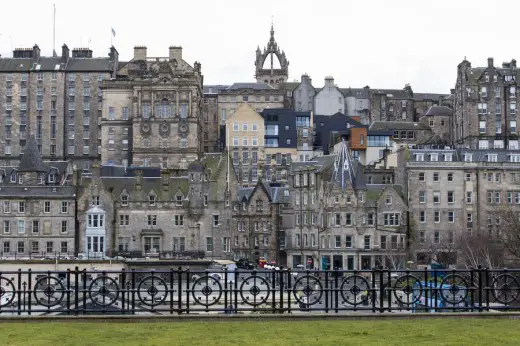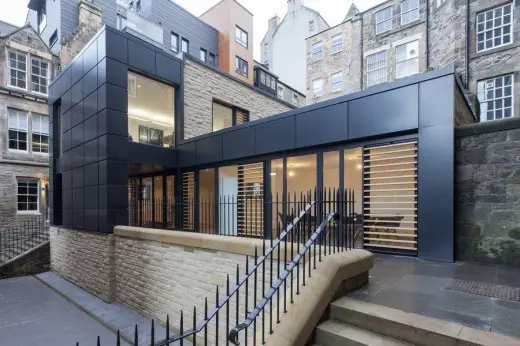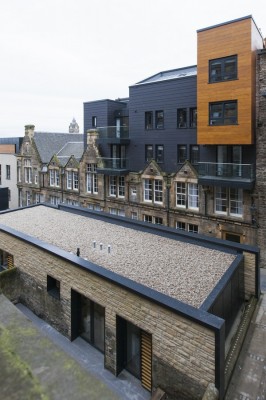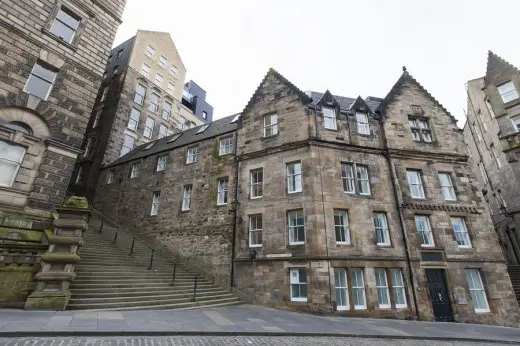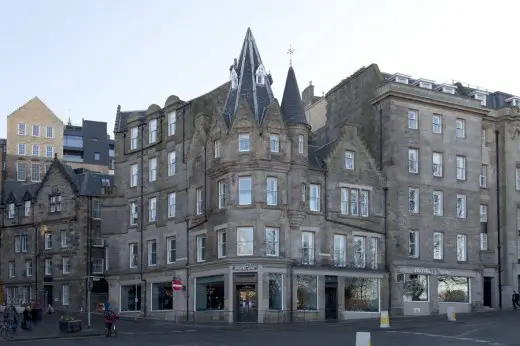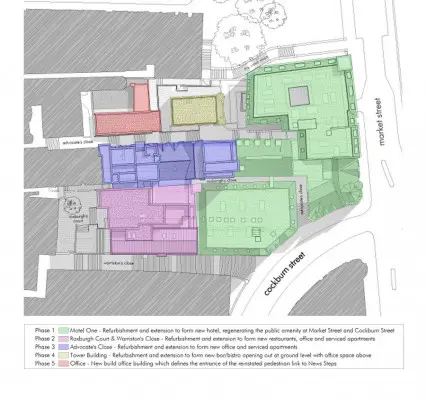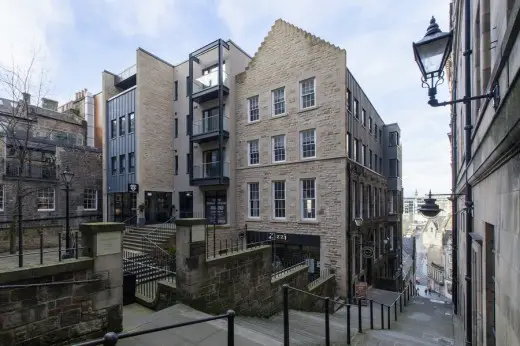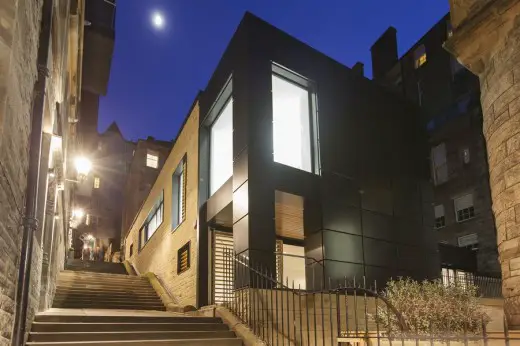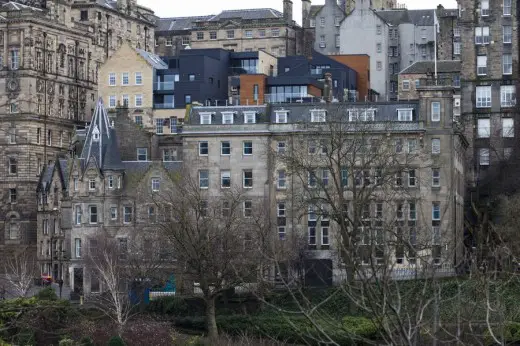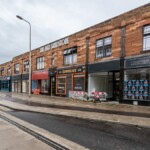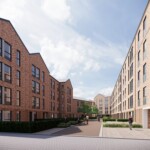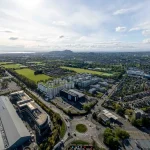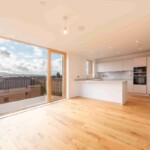Advocate’s Close Edinburgh, EAA Award, Scpttish Capital Building Images, Architect, Old Town Architecture
Advocate’s Close Edinburgh
Mixed-Use Development Old Town design by Morgan McDonnell Architecture
31 Mar 2015
Advocate’s Close Award
Design: Morgan McDonnell Architecture
Advocate’s Close wins the overall EAA Award.
e-architect’s Isabelle Lomholt and Adrian Welch attended the awards ceremony at Edinburgh Centre for Carbon Innovation, completed in September 2013 by Malcolm Fraser Architects, last year’s EAA Awards Building of the Year
The EAA Awards are designed to create a showcase for the Architectural profession to demonstrate its skills and its contribution to the environment and the economy. The EAA Awards highlight the excellent work undertaken within the Chapter Area and by Architects in general.
EAA Building of the Year
A silver medal is given to acknowledge and publicise excellence in architecture for a completed project within the Chapter area. It may be a new building, an extension, an alteration or a conversion and it must have been designed by a Chartered Architect. No cost constraints are placed on this award.
The Award is marked by the presentation of an engraved silver medal and accompanying Certificate. Commendation Certificates may also be awarded at the discretion of the judging panel. The award is made to the practice that carried out the commission.
Advocate’s Close wins RIAS Andrew Doolan Best Building in Scotland
Advocate’s Close, Edinburgh by Morgan McDonnell Architecture has been awarded the RIAS Andrew Doolan Best Building in Scotland Award for 2014. From a shortlist of thirteen projects, all winners of RIAS Awards for 2014 (presented in June 2014), the judges selected Advocate’s Close as a clear winner. The award was presented at a ceremony at the National Museum of Scotland (Doolan Award 2011) by the Cabinet Secretary for Culture and External Affairs, Ms Fiona Hyslop MSP with Mrs Margaret Doolan Hon FRIAS (the late Andrew Doolan’s mother).
Anthony McDonnell, Guy Morgan & Chris Stewart:
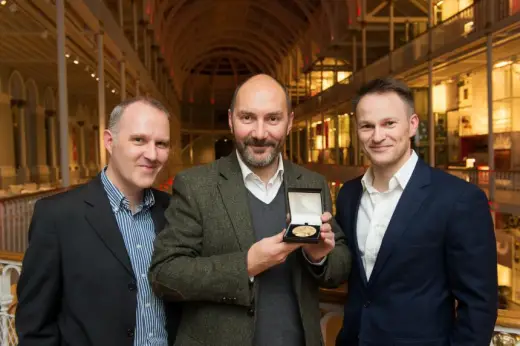
photo © Malcolm Cochrane
This year’s ceremony was also one of reflection and remembrance, following the death of the judging chair, Professor Andy MacMillan OBE FRIAS, who died suddenly during the Awards visits. RIAS President, Iain Connelly commented:
“Andy was a great architect, an educator of international renown and one of the finest human beings it has been my privilege to know. His influence on generations of students at the Mackintosh School of Architecture and in the many other institutions where he taught, was immense.
Andy will be remembered as someone who lived life to the full, who inspired all those he taught and all those who encountered him, as an individual of enormous talent, tremendous enthusiasm and irrepressible fun. Andy’s legacy is the hugely improved built environment of Scotland wrought by his own hand and those of successive generations of his students. He will forever be missed.”
The winner of this year’s RIAS Andrew Doolan Best Building in Scotland Award receives a gold medal cast by internationally renowned Scottish Goldsmith, James Brent Ward and a cheque for £25,000. This makes it the richest architectural prize in the UK and one of the most significant awards in Europe. The award is generously supported by the late Andrew Doolan’s family and by the Scottish Government.
6 May 2014
Advocate’s Close Completion
Design:Morgan McDonnell Architecture
Situated in the heart of Edinburgh’s Old Town, this historic site was formerly occupied by the City of EdinburghCouncil and encompasses 9 listed buildings over 11 storeys and bridging 3 closes between the High St, Cockburn St and Market St. Advocate’s Closeform a vibrant new quarter in the Old Town that combines therehabilitation of historic buildings and public realm with alterations and interventions which participate in thecontinuing organic architectural evolution of the Old Town. The design proposals borrow from the eclectic rangeof historic architectural forms and styles, each redolent of their particular era, to continue the established patternof overbuilding and modification. Whilst retaining all of the existing buildings, twenty-first century elements havebeen carefully added to reinstate the historic form and mass of the site.
The mixed use scheme provides a new 208 room hotel – the UK’s first Motel One, 37 serviced apartments onthe upper levels with restaurants, offices, bars & cafes opening on to and enlivening the surrounding squares &closes. It also includes a new pedestrian thoroughfare linking Advocate’s Close with the News Steps.
History
The characteristic herringbone pattern of development in the old town evolved from the tight feuing of propertyfronting the High Street and was well established by the mid-16th century. As the population of the area aroundthe High Street grew through to the end of the 18th century, the potential for further development within thisframework had been more or less exhausted with tenement properties of up to ten storeys.
The city improvement act of 1827 sought to bring elements of rational planning and order to the medieval clutterof the old town, and informed the design of George IV Bridge and latterly Cockburn Street. Meanwhile, newbuildings were constructed to address the newly formed Market Street, facing north towards the New Town.Advocate’s Close and Roxburgh’s Close were left as a result with closed vistas and connected to CockburnStreet via a perpendicular access way.
Following the demolition of many of the tenement buildings through the 19th century, much of the land wasredeveloped for light industrial and commercial use such as warehousing. The site became home to the officesMorgan McDonnell Architecture Ltd. and printing press of the Evening News following the construction of a new boiler house in 1896. The City ofEdinburgh Council gradually acquired ownership of buildings across the site on a piecemeal basis over thecourse of the 20th century as their requirement for administrative offices grew. The Council vacated in 2006,having moved to new premises at East Market Street and the entire site was offered for sale.
Old Town Mixed-Use Development design by Morgan McDonnell Architecture
Design
The design proposals within the context of the existing range of buildings and important heritage settingrequired to balance the following primary objectives:
a) Make the best use of existing buildings in terms of efficient use of resources, retention of architecturalheritage and to create a desirable place to stay, work and socialise in order to guarantee continued habitationand maintenance of the building fabric and civic vitality.
b) Respond positively to conservational aspirations for the enhancement of the world heritage site andconservation area, whilst at the same time promoting contemporary design, in this case, as a rational means ofresolving inherent problems of the site, knitting together disparate constructional and spatial elements and topresent a more coherent idea of the architectural evolution of buildings on the site. In consequence of theabove, a three point development plan was proposed whereby, following careful consideration of the site andcontext, the strategy enabling re-use of existing buildings and land essentially involved either reinstatement,modification or extension.
Old Town Mixed-Use Development Public Realm
Public Realm
The existing building frontages made little contribution to street level activity or character and presented apredominantly closed, and in some cases, poorly maintained street frontage. The new development includesnew café-restaurant facilities opening onto Roxburgh Court, improving the square’s amenity as a focal orstopping point. A new bar-bistro and offices open out on to Advocate’s Close, while the hotel’s front of housefacilities, which include lobby and lounge, reception, bar and breakfast areas provide a lively active frontage onto Market Street and Cockburn Street.
Pedestrian routes through the site are rich in contrast between enclosed and open space, sequentialexperiences of view and vista as well as building form and detail which combine to create strong impressions oftransition and arrival as access and nodal points. This permeability also provides useful pedestrian shortcutsfrom the High Street to Market Street, Cockburn Street, Princes Street Gardens and Waverley Station.The new link from The News Steps also improves connectivity and movement through the site, effectivelyreinstating the former connection of The News Steps and Advocates Close which was lost in 1928.
Private Realm
The layout of the serviced accommodation seeks to provide the best achievable amenity in day lighting, privacyand views within the challenging context of the tight historical context and reuse of existing buildings. Allserviced apartments are located at first floor or above and over commercial uses. Opportunities to createprivate terraces and balconies have been exploited wherever possible to better reflect the historical character ofthe old town.
Old Town Mixed-Use Construction
Construction – The Challenges
Though the existing buildings range in age considerably, the overwhelming majority of existing built structuredates from 1850 or later. The buildings were also in considerably differing states of repair. In order to bring suchbuildings into new use, a high standard of repair and renewal was necessary to ensure compliance withcontemporary standards for the integrity of the building fabric and services, whilst maintaining the integrity ofmaterial and detail present in the listed buildings.
The complex and restrictive nature of the site and the variance in levels dictated that the construction methodsused were unconventional and bespoke to the development. No cranes were used and all primary structuralelements were manhandled around site and into place. Many building elements had to be formed in situ aslarger components could not be manoeuvred in and around the site.
The building programme was in turn particularly complex to accommodate these construction methods and toalso fit around a variety of events in the city, such as the Edinburgh Fringe Festival, to ensure minimal impact onactivity around the site.
Construction – Reinstatement
As well as re-establishing pedestrian routes through the site, additional storeys have been added to the building fronting Warriston’s Close which reinstate the floor levels previously removed during unsympathetic remodelling in the early twentieth century. Largely clad in zinc, to clarify its contemporary role in the historic narrative of the site, the extension is book-ended by new sandstone crow step gables which present a cohesive material impression from the wide civic vista to the north as well as the intimate enclosure of Roxburgh’s Court to the south, whilst blending harmoniously in scale with the City Chambers block adjacent.
Similarly, additional storeys were added above existing buildings on Advocates Close to reinstate the characteristic building mass of the site where earlier phases of higher historic development had been removed leaving large expanses of featureless gable visible to prominent view.
Construction – Modification
Within the existing form of development new and inventive means of accommodating the proposed new uses had to be found. The interlinking of five separate buildings to form the hotel required careful remodelling to create efficient usable accommodation and a rational circulation strategy to overcome the labyrinthine quality of the existing structures and aid building orientation. A new lightwell was formed at the centre of the main block as a key orientation point which brought daylight to the lift lobbies and allowed additional bedrooms to be located at the heart of the deep plan. A new bridge enclosure spans Roxburgh’s Close linking the two main hotel wings which was formed in frameless glass to respect the setting of the Close. Similar strategies were developed across the site with new steel frames and new floor levels carefully inserted so as not to impair existing windows. Roxburgh’s Close was reopened at its north end and resurfaced, while the existing building which spans above was remodelled to provide circulation space with curtain glass facades both ends as a key orientation space which echoed the historic route below.
Construction – Extension
New extensions were added where opportunities arose to sympathetically enhance the existing form of development which made efficient use of existing structures by subtle intensification and provided additional accommodation which particularly benefitted from the unique historic setting and dramatic amenity of view. Additional storeys added to buildings at Advocates Close, Warriston’s Close, Cockburn Street and Market Street provided valuable new space accommodating serviced apartments, office and hotel uses, whilst a newbuild office building on the previously cleared west side of Advocates Close reinstates the historic building line and re-establishes the enclosed nature of the Close itself.
Advocate’s Close Completion – Building Information
Project Name: Advocate’s Close
Location: Old Town, Edinburgh
Completion: 2013
Architect: Morgan McDonnell Architecture Ltd
Client: Chris Stewart Group
Contract Value: Ł20 million
Photographs: Kevin McCollum
Advocate’s Close information from Morgan McDonnell Architects
Scottish Capital Building Designs
Scottish Capital Property Designs – recent architectural selection below:
Scottish Parliament

picture © Keith Hunter
Calton Gate
image : ANTA architecture
Hotel Missoni Edinburgh
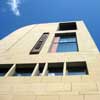
photograph © Adrian Welch
Comments / photos for the Advocate’s Close Completion – Edinburgh Architecture page welcome
Advocate’s Close Completion – page
